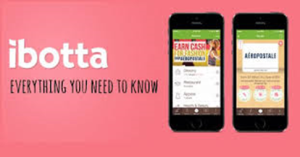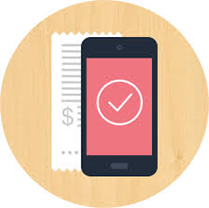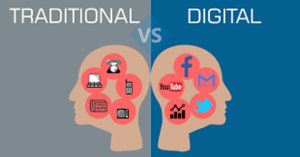 Is the marketing industry going through an existential crisis? What is the future going to look like? Should companies turn to all digital platforms and forget the past and forgo traditional methods? Well it may be surprising to learn that Clear Channel is refusing to pay its rent for billboards claiming that the ROI is not worth the price (Spainer, 2016). This is not the only company shifting focus to more digital and dynamic platforms to advertise. It seems that a poster no longer grabs enough attention for people to look away from their phones. Many feel that integration of traditional and digital marketing is best to reach consumers (Cave, 2016), however, it seems that the print is fading fast due to the expense and legacy deals that no longer make sense. I think that the shift has already occurred and within the next few years; a billboard or poster will be obsolete. It simply comes down to the response from consumers.
Is the marketing industry going through an existential crisis? What is the future going to look like? Should companies turn to all digital platforms and forget the past and forgo traditional methods? Well it may be surprising to learn that Clear Channel is refusing to pay its rent for billboards claiming that the ROI is not worth the price (Spainer, 2016). This is not the only company shifting focus to more digital and dynamic platforms to advertise. It seems that a poster no longer grabs enough attention for people to look away from their phones. Many feel that integration of traditional and digital marketing is best to reach consumers (Cave, 2016), however, it seems that the print is fading fast due to the expense and legacy deals that no longer make sense. I think that the shift has already occurred and within the next few years; a billboard or poster will be obsolete. It simply comes down to the response from consumers.
Do you think this is true? When do you think this official transfer will occur?
Another marketing tool that is going under a transformation is the coupon. Many CPG companies use coupons to help build brand awareness and increase consumer pull at the point of purchase. But in today’s market, a brand needs to stand out on the shelf and increase the likelihood of a purchase. Providing a coupon can influence consumer behavior and help build recognition, which will hopefully result in a lasting relationship with the brand. But is anyone cutting coupons anymore? If so, are they the brand’s target market?
It would make sense to add value where the consumers are naturally hanging out. Mobile phones are very prevalent and embedded in today’s culture in the US. They are always around and are constantly being used. 81% keep their phones handy and check them multiple times a day up to multiple times an hour (Newport, 2015). Facebook knows this well and has created a type of coupon that is highly integrated with online and offline purchases (Swant, 2016). This may be a great option for certain brands, but there is another service that I have found that seems to be a good alternative. I am wondering if you will agree.
 IBOTTA is an app that provides a platform for companies to run promotions and coupons so they are accessible to consumers directly on their mobile phones. IBOTTA does have the attention of consumers, especially the Millennials, who are the most coveted generation to win over (or at least with my brands). It provides consumer insights as it tracks every purchase that redeems a promotion. It is legal in most states, and as long as the account provides an itemized receipt, the savings is transferred directly into PayPal or Venmo.
IBOTTA is an app that provides a platform for companies to run promotions and coupons so they are accessible to consumers directly on their mobile phones. IBOTTA does have the attention of consumers, especially the Millennials, who are the most coveted generation to win over (or at least with my brands). It provides consumer insights as it tracks every purchase that redeems a promotion. It is legal in most states, and as long as the account provides an itemized receipt, the savings is transferred directly into PayPal or Venmo.
The convenience factor is high and the campaigns are typically less expensive than traditional campaigns, as the company only pays for redemptions versus pay per clip or circulation. There are multiple options in gaining more insights and engagement by having consumers complete a quick survey or watch a short clip before the coupon is made available. Companies also have the option to run the promotion until it reaches a cap which is predetermined and the deal automatically shuts off making sure the brand does not overspend its budget (Classen, n.d.). This allows for companies to have more control over the spend and really reach out to its target market.
 IBOTTA also does not just work at retail store but restaurants as well. This channel is sometimes difficult to target, yet this app makes it some simple. The same rules apply. However, there are some downsides to this app. There is no way to give away anything other than “cash”. For example, if a brand wanted to create a point system and give away swag through IBOTTA, this cannot be done. Which then brings into question of this will truly increase brand loyalty in the long run. The again, did clipping coupons create more lasting brand loyalty?
IBOTTA also does not just work at retail store but restaurants as well. This channel is sometimes difficult to target, yet this app makes it some simple. The same rules apply. However, there are some downsides to this app. There is no way to give away anything other than “cash”. For example, if a brand wanted to create a point system and give away swag through IBOTTA, this cannot be done. Which then brings into question of this will truly increase brand loyalty in the long run. The again, did clipping coupons create more lasting brand loyalty?
IBOTTA will not be on the only alternative out there to speak to consumers, but it is an interesting option for the right business. Coupons directly placed on the package still seem create a lift in sales, but with the more distractions, these may eventually disappear like the static billboards. It will still take some time, but digital is the future.
References
Classen, S. (n.d.) IBOTTA. Retrieved from: https://www.dropbox.com/s/v3foxfwi3tsie7t/Ibotta%20Overview%20Deck%20-%20BW%26S.pdf?dl=0
Cave, J. (2016 July 14). Digital Marketing Vs. Traditional Marketing: Which One Is Better? Digital Donut. Retrieved from: https://www.digitaldoughnut.com/articles/2016/july/digital-marketing-vs-traditional-marketing
Knight, K. (2016 October 31). Reports ID coupon, mobile as engagers. BizReport. Retrieved from: http://www.bizreport.com/2016/10/reports-id-coupon-mobile-as-engagers.html
Newport, F. (2015 July 9). Most U.S. Smartphone Owners Check Phone at Least Hourly. Gallup. Retrieved from:http://www.gallup.com/poll/184046/smartphone-owners-check-phone-least-hourly.aspx
Spanier, G. (2016 October 31). Is the traditional billboard facing terminal decline? Campaign. Retrieved from http://www.campaignlive.co.uk/article/traditional-billboard-facing-terminal-decline/1413562#
Swant, M. (2016 August 30). Facebook Has Created the Digital Equivalent of a Coupon Drawer for Users. Adweek. Retrieved from: http://www.adweek.com/news/technology/facebook-has-created-digital-equivalent-coupon-drawer-users-173200




3 Responses to Can Traditional Marketing Still Play?